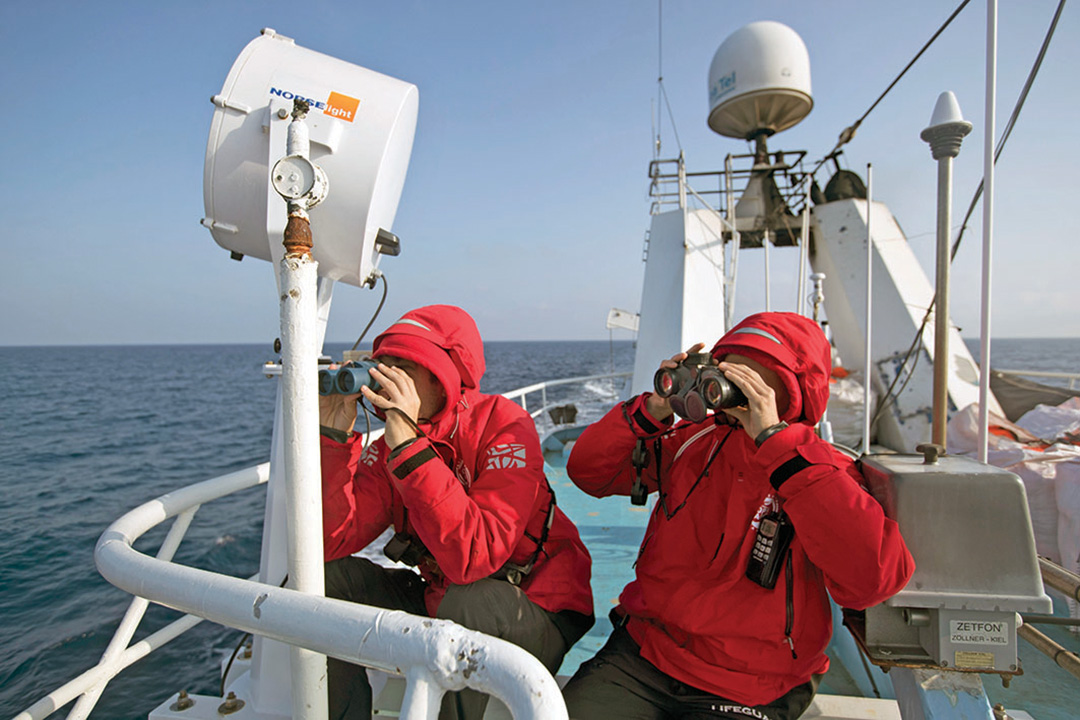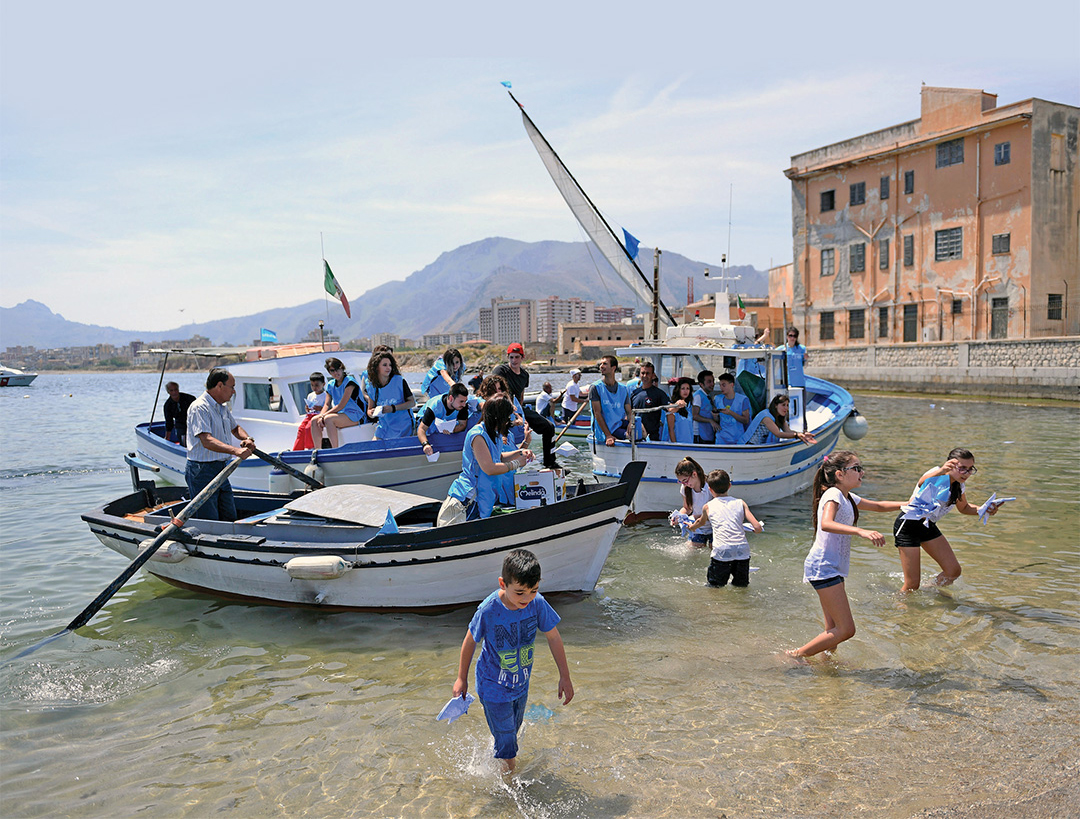International Law and Maritime Migration
By Melina Lito Photos by THE ASSOCIATED PRESS
In 2015, the United Nations High Commissioner for Refugees (UNHCR) reported that the number of refugees and migrants crossing the Mediterranean Sea to reach Europe had surpassed 300,000 that year, up from 219,000 in 2014. The UNHCR also said that “2,500 refugees and migrants are estimated to have died or gone missing this year while attempting the crossing to Europe — compared to 3,500 who died or went missing in the Mediterranean in 2014.”
Italy had established the search and rescue operation Mare Nostrumin 2013, offering migrants medical treatment, shelter, food and even legal assistance. But Mare Nostrum ended in October 2014 “because it was an emergency operation,” Italian Interior Minister Angelino Alfano said. In July 2017, refugees traveling on a lifeboat from Morocco to Spain were feared drowned in the Mediterranean, and only three were confirmed alive. The 49 probable deaths makes it the deadliest incident in the Western Mediterranean in 2017. In August 2017, the German nongovernmental organization Sea-Eye ended its rescue operations on the Mediterranean because of security concerns, citing an “explicit threat against the private NGOs” from the Libyan government.
In this sensitive time, when migrants and refugees are losing their lives in the Mediterranean as they try to escape escalating humanitarian crises and political turmoil, the complexities that govern the maritime security field needs to be further analyzed. This is a complex area of law and policy, and it arguably involves both international maritime law, which regulates the conduct of ships at sea, and international migration law, which regulates the general treatment of migrants and refugees.
Aid and assist
The U.N. Convention on the Law of the Sea (UNCLOS) was negotiated with the intent that the “progressive development of the law of the sea achieved in this Convention will contribute to the strengthening of peace, security, cooperation and friendly relations among all nations in conformity with the principles of justice and equal rights and will promote the economic and social advancement of all peoples of the world, in accordance with the Purposes and Principles of the United Nations as set forth in the Charter.” Under Articles 98(1)-(2) of the convention, member states and ship captains are required to assist those distressed at sea and coastal member states are required to establish and promote search and rescue operations at sea.

scan the Mediterranean Sea for refugee boats.
Moreover, the International Convention on Search and Rescue (SAR) sets out in its preamble to establish an “international maritime search and rescue plan responsible to the needs of maritime traffic for the rescue of persons in distress at sea.” Chapter 2 of SAR obligates coastal member states to arrange for adequate search and rescue services for those in distress at sea. It also elaborates that search and rescue regions be defined through agreements or other arrangements with other states. “In case agreement on the exact dimensions of a search and rescue region is not reached by the Parties concerned, those Parties shall use their best endeavors to reach agreement upon appropriate arrangements under which the equivalent overall coordination of search and rescue services is provided in the area. The Secretary-General shall be notified of such arrangements.” Furthermore, SAR provides “that assistance be provided to any person in distress at sea. They shall do so regardless of the nationality or status of such a person or the circumstances in which that person is found.” The International Convention for the Safety of Life at Sea (SOLAS) is generally regarded as the most important of all international treaties concerning the safety of merchant ships. SOLAS applies “to ships entitled to fly the flag of States of Governments of which are the Contracting Governments.” Chapter 5 obligates member states to “ensure that any necessary arrangements are made for coast watching and for the rescue of persons in distress at sea round its coasts. These arrangements should include the establishment, operation and maintenance of such maritime safety facilities as are deemed practicable and necessary having regard to the density of the seagoing traffic and navigational dangers and should, so far as possible, afford adequate means of locating and rescuing such persons.”
SOLAS was amended in 2004 to provide guidance on what the security plan should be when engaging with a ship that has been at a port of a nonstate party or has engaged with a ship that is not required to apply the International Ship and Port Facility Security Code. These amendments lay out that the “denial of entry into port shall only be imposed when the duly authorized officer(s) have clear grounds to believe that the ship poses an immediate threat to the security or safety of persons, ships or other property and there are no appropriate means for removing the threat.”
Refugee rights
Overall, while UNCLOS, SAR and SOLAS govern international maritime law and provide the framework for ship engagement on search and rescue missions, at the other end of the spectrum is the international migration law framework, which this author examined in more detail in a previous issue (Vol 7, Issue 1, 2016). Thus, this article focuses more on the Refugee Convention.
The Refugee Convention, under Article 12, obligates member states to expel a refugee only on grounds of national security or threat to public order, and only if the decision to expel has been “reached in accordance with due process of law. Except where compelling reasons of national security otherwise require, the refugee shall be allowed to submit evidence to clear himself, and to appeal to and be represented for the purpose before competent authority or a person or persons specifically designated by the competent authority.” Moreover, under Article 33 and the non-refoulement principle, member states are generally prohibited from expelling a refugee to his/her country of origin if it poses a risk of persecution based on nationality, political opinion, race, religion or membership in a particular social group. There is an exception, however, if the refugee is a threat to national security “or who, having been convicted by a final judgment of a particularly serious crime, constitutes a danger to the community of that country.”

Thus, on one hand, international maritime law obligates ships and ship captains to perform search and rescue operations when they encounter someone in distress. It even obligates ships to know the intricacies of how such operations will be carried out in neighboring territories via regional agreements. Similarly, the UNCLOS regulates for the search and rescue of those distressed on the high seas. It can be concluded, therefore, that when a ship or ship master from a state that is party to these conventions encounters a vessel carrying people in distress, they are in fact empowered to provide assistance. On the other hand, the Refugee Convention provides protection to refugees fleeing their country of origin because of persecution. It protects them when they enter the host country, and it protects them from being sent back with the principle of non-refoulement, absent threats to national security and public order.
While the movement of people across international borders has many positive impacts (especially from a socioeconomic and cultural diversity perspective), there are also security threats related to trafficking, smuggling and organized crime. U.N. Security Council Resolution (SCR) 1373 “[n]otes with concern the close connection between international terrorism and transnational organized crime, illicit drugs, money-laundering, illegal arms trafficking, and illegal movement of nuclear, chemical, biological and other potentially deadly materials, and in this regard emphasizes the need to enhance coordination of efforts on national, subregional, regional and international levels in order to strengthen a global response to this serious challenge and threat to international security.” SCR 1373 also calls on state parties to “[t]ake appropriate measures in conformity with the relevant provisions of national and international law, including international standards of human rights, before granting refugee status, for the purpose of ensuring that the asylum-seeker has not planned, facilitated or participated in the commission of terrorist acts.” Finally, the New York Declaration on Migrants and Refugees recognized, “the particular vulnerabilities of women and children during the journey from country of origin to country of arrival. This includes their potential exposure to discrimination and exploitation, as well as to sexual, physical and psychological abuse, violence, human trafficking and contemporary forms of slavery.” These security challenges are relevant in the context of land and sea borders and perhaps even harder to resolve in the context of maritime immigration when so many actors are involved.
For example, it is understood that the ship captain is responsible for search and rescue, and that the receiving port is responsible for expulsions based on national security and public order. But more understanding is needed when trying to determine which entity is responsible for deciding that someone on a ship is a national security threat. For instance, in the event crewmembers are designated to perform the screening, then systems must be in place to ensure they are properly trained. Similarly, more discussions and planning are needed on what to do with the rescued people after a ship has been denied entry to a port because of security concerns. How should the group of rescued migrants be treated and where should they be sent?
These are complex matters of law and policy because they are also tethered to border security considerations and require an allocation of resources and extensive collaboration from state, international and private actors. But with the rise in the number of people fleeing conflict and making the journey by boats, especially vessels that are not fit for this purpose, such questions become more relevant and urgent.
The ideas expressed in this article are the author’s and do not constitute legal advice.


Comments are closed.